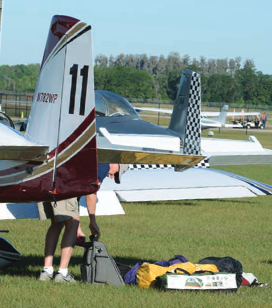You Can’t Take All That!
What Aircraft Weight & Balance Means to You
by Susan Parson, FAA Safety Briefing Mar/Apr 2018
[Editor’s Note: This article is adapted from the JulAug 2014 issue of FAA Safety Briefing.]

One of the joys of GA airplane travel is that you don’t have to limit liquids and gels, remove your shoes, or go through airport security scanners. So you pack everything you want, only to discover that your personal pilot is far more ferocious than the stone-faced screeners at Big Airplane Airport. Upon seeing your bags and bundles, your pilot freezes, scowls, and states (or shouts): You can’t take all THAT in THIS airplane!
Your offer to squeeze it all in doesn’t soothe the pilot. On the contrary, he or she gets even more agitated because “you just don’t understand how it works!”
Because knowing something about the basics of aircraft weight and balance could reduce some of the tension that can arise, here’s the story.
A-Weigh We Go
The description of GA aircraft as “light airplanes” is apt, because light is the name of the game. The lighter the airplane, the faster and higher it can fly with a given engine. Also, keeping the aircraft light enables the pilot to carry more fuel, more passengers, and/or more cargo.
Notice that I said “and/or” — not just “and.” GA flying involves tradeoffs. The presence of four seats doesn’t mean it can always carry four passengers, especially if those passengers have baggage. Nor can the pilot just fill the tanks and launch. Here’s why.
To stay aloft, the airplane’s wings must be able to generate enough lift to equal the weight of the airplane and everything it carries. When an airplane is made, its manufacturer determines its maximum gross weight — stating, in essence, that the airplane can generate enough lift to carry that amount of weight. The pilot decides how to use the set “weight allowance” on any given flight. In most cases, it is simply not possible to load a light GA aircraft with full fuel, full seats, and passenger bags without grossly exceeding maximum gross weight. So the pilot has to make choices about how many passengers, how much baggage, and how much fuel to carry (which could result in more fuel stops).
Hanging in the Balance
Having dutifully limited your luggage, now you wonder why the pilot starts rearranging the items you’ve stowed in the baggage compartment, and why there are passenger seat assignments.
That’s where the “balance” part comes in. To be stable in all phases of flight, an airplane’s weight must be balanced around a point within a fairly narrow range of values established when the airplane is manufactured. The idea is to avoid loading the airplane in a way that makes it either nose-heavy or tail-heavy.
To achieve this goal, the pilot uses the manufacturer’s charts and graphs, or apps containing that data, to make a weight and balance calculation. To determine weight, the pilot starts with the airplane’s published empty weight, and totals the weights for passengers, bags, and fuel to calculate the total weight.
After verifying that total weight is below maximum gross weight, the pilot calculates the airplane’s “center of gravity,” or CG. This process involves multiplying each component of the weight by the published “station” value for its position in the airplane to produce a value called the “moment.” The pilot divides total moments by total weight to determine the CG — the airplane’s balance point. The final step is verifying that the CG is within the acceptable range. If so, good to go. If not, the pilot moves passengers or bags until the CG is acceptable.
Once weight and balance and CG are within acceptable limits, away you go!
Susan Parson (susan.parson@faa.gov, or @avi8rix for Twitter fans) is editor of FAA Safety Briefing. She is an active general aviation pilot and flight instructor.
|